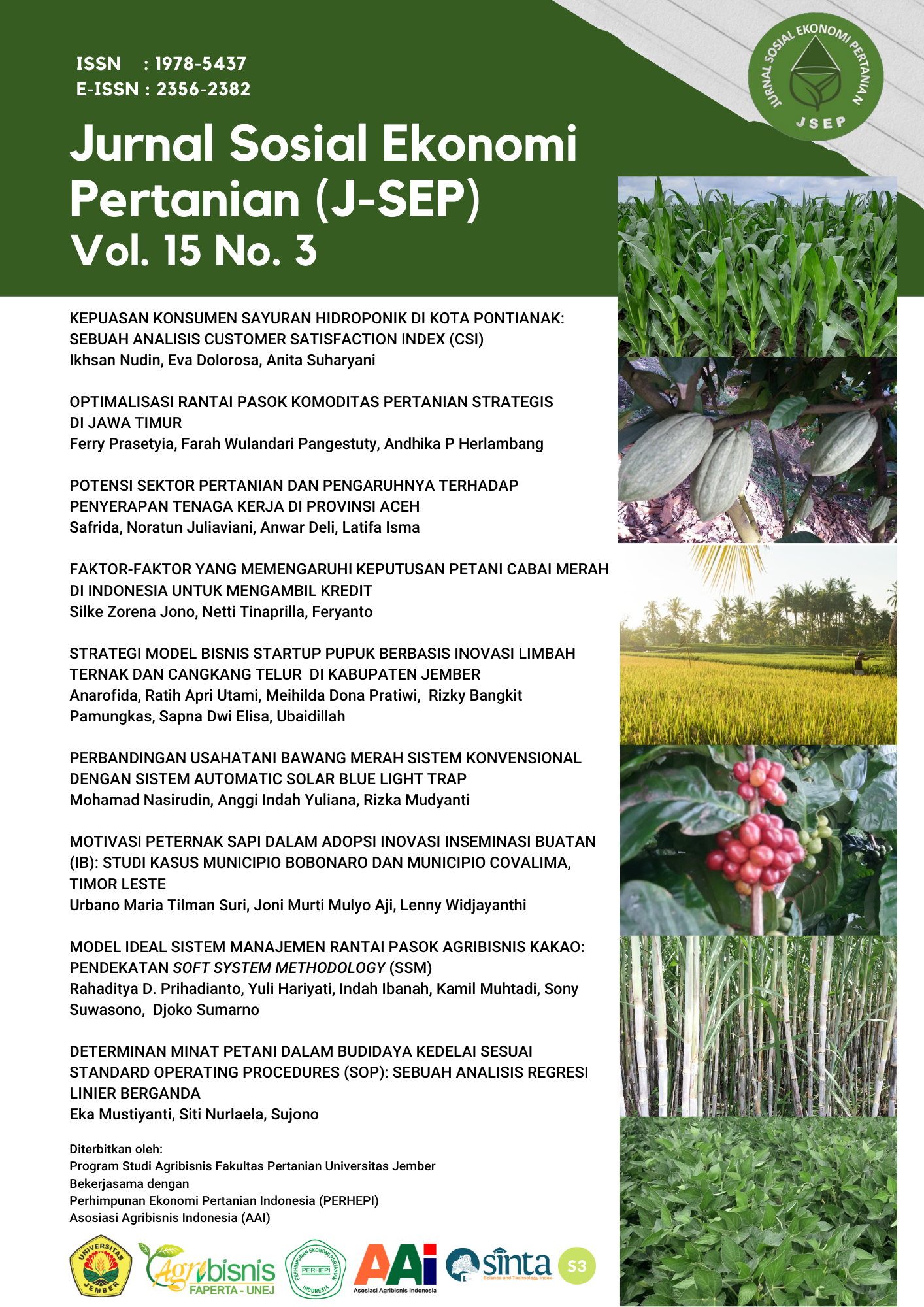Motivasi Peternak Sapi Dalam Adopsi Inovasi Inseminasi Buatan (IB): Studi Kasus Municipio Bobonaro Dan Municipio Covalima, Timor Leste
Abstract
Since 2016, cattle farmers in Municipio Bobonaro and Municipio Covalima have carried out IB for their livestock, although there are still some farmers who do not or cannot do due to lack of access. This is related to the motivation of farmers with artificial insemination programs. The aim of our study was to determine the level of motivation regarding the cattle artificial insemination (IB) program, the level of adoption of IB program and to analyze the relationship between farmer characteristics and motivation regarding the IB program and the level of adoption of IB program innovation in cattle business in the municipality of Bobonaro and Covalima municipality. This research was conducted using a survey method approach and was carried out in the Municipio Bobonaro and Municipio Covalima. A total of 44 farmers participated in the program were included in the sample using a census strategy. Chi squared correlations, Spearman Rho, and quantitative descriptive analysis were used to analyze the data. The results showed that the level of motivation of farmers regarding the artificial insemination program included high criteria, while the level of innovation adoption of artificial insemination programs included medium criteria. Experience of raising cattle had a significant relationship with the motivation of farmers.
References
Boediyana, T. (2008, September). Menyongsong Agribisnis Persusuan yang Prospektif di Tanah Air. Trubus, 108.
Brady, R. P. (2008). Work Motivation Scale, Administrator ’ s Guide. Shadeland, Indianapolis: JIST Publishing.
Eklundh, C. (2013). The use of artificial insemination in dairy farms in urban/peri-urban Kampala, Uganda – a study of knowledge, attitude and practices. Swedish University of Agricultural Sciences, 4(2), 1–33.
Gordon, I. R. (2004). Reproductive technologies in farm animals. Oxfordshire, United Kingdom: CABI Publishing.
Groves, R. M. (2010). Survey Methodology. New York: Wiley.
Mulyani, S. I., & Yusuf. (2018). Adopsi Inovasi Peternak Sapi Program Inseminasi Buatan di Kabupaten Nunukan Kalimantan Utara. Prosiding Seminar Teknologi Dan Agribisnis Peternakan VI: Pengembangan Sumber Daya Genetik Ternak Lokal Menuju Swasembada Pangan Hewani ASUH, Fakultas Peternakan Universitas Jenderal Soedriman, 297–301.
Nugraha, A., Syarif, I., & Saputra, F. R. (2020). Peningkatan Kesejahteraan Peternak Sapi Potong Sistem Bagi Hasil di Kecamatan Kulo, Kabupaten Sidenreng Rappang, Propinsi Sulawesi Selatan. PETERPAN (Jurnal Peternakan Terapan), 2(1), 1–6. https://doi.org/10.25181/peterpan.v2i1.1635
Prasetyo, A. F., & Suryadi, U. (2017). Faktor-Faktor Yang Mempengaruhi Tingkat Adopsi InovasiDan Kapabilitas Peternak Pada Kelompok Ternak Kambing (Factors Affecting the Innovation Adoption Rate and Livestock Breeders Capability in Goat Farming Group). Jurnal Ilmiah INOVASI, 17(2), 62–66.
Putri, T. D., Siregar, T. N., Thasmi, C. N., Melia, J., & Adam, M. (2020). Faktor-Faktor Yang Memengaruhi Keberhasilan Inseminasi Buatan Pada Sapi Di Kabupaten Asahan, Sumatera Utara. Jurnal Ilmiah Peternakan Terpadu, 8(3), 111–119. https://doi.org/10.23960/jipt.v8i3.p111-119
Robbins, S. P., & Judge, T. A. (2013). Organizational Behavior (15th ed.). New York: Prentice Hall.
Romjali, E., Edwardi, & Rusdiana, S. (2012). Peluang dan Potensi Usaha Ternak Kerbau di Sumatera Barat (Business Opportunities and Potential of Buffalo in West Sumatra). Lokakarya Nasional Perbibitan Kerbau, 60–68.
Shehu, B., Rekwot, P., Kezi, D., Bidoli, T., & Oyedokun, A. (2011). Challenges to Farmers’ Participation In Artificial Insemination (AI) Biotechnology In Nigeria: An Overview. Journal of Agricultural Extension, 14(2), 123–129. https://doi.org/10.4314/jae.v14i2.64128
Sirajuddin, S. N., Lestari, V. S., & Fadliah, N. S. (2013). Perbandingan Pendapatan Peternak Sapi Bali yang Melakukan Program Inseminasi Buatan ( IB ) dan Tidak Melakukan Program Inseminasi Buatan (IB) di Kec. Soppeng Riaja Kabupaten Barru. Jurnal Ilmu Ternak, 13(1), 1–3.
Sugiyono. (2017). Metode Penelitian Kuantitatif, Kualitatif dan R&D. Bandung: Alfabeta.
Swastika, I. G. L., Inggriati, N. W. T., & Adi Putra, I. . G. S. (2018). Analisis Keberhasilan Inseminasi Buatan Pada Sapi Bali Di Kabupaten Karangasem. Majalah Ilmiah Peternakan, 21(1), 24–28. https://doi.org/10.24843/mip.2018.v21.i01.p05
Vicente, J., Guntoro, B., & Sulastri, E. (2009). Tingkat dan Struktur Adopsi Inovasi pada Peternakan Sapi Potong Bantuan Cooperativa Cafe Timor di Timor Leste. Prosiding Seminar Nasional Lustrum VII Fakultas Peternakan Universitas Gadjah Mada Yogyakarta, 87–98.
Wirartha, M. (2006). Metodologi Penelitian Sosial Ekonomi. Yogyakarta: CV. Andi Offset.
Yasin, M., & Priyono, J. (2016). Analisis Faktor Usia, Gaji dan Beban Tanggungan terhadap Produksi Home Industri Sepatu di Sidoarjo (Studi Kasus di Kecamatan Krian). Jurnal Ekonomi Dan Bisnis, 1(1), 95–120.

This work is licensed under a Creative Commons Attribution-ShareAlike 4.0 International License.
Jurnal Sosial Ekonomi Pertanian (J-SEP) has CC-BY-SA or an equivalent license as the optimal license for the publication, distribution, use, and reuse of scholarly work.
The work is simultaneously licensed under a Creative Commons Attribution-ShareAlike 4.0 International License, which permits others to share the work with an acknowledgement of the authorship and the work's initial publication in this journal. Authors who publish with this journal retain their copyright and grant the journal the right of first publication.


3.png)






.png)













